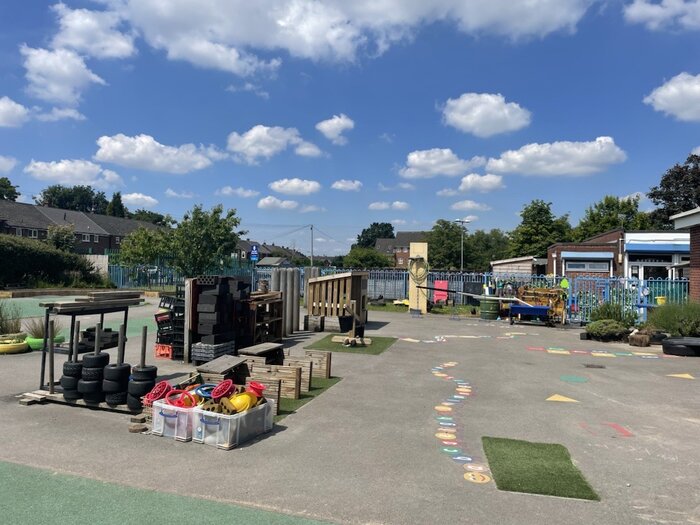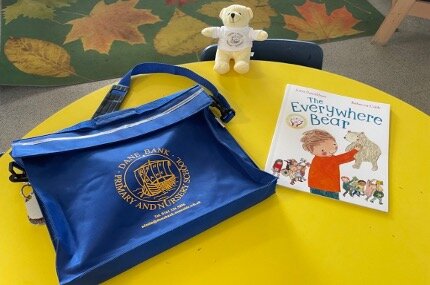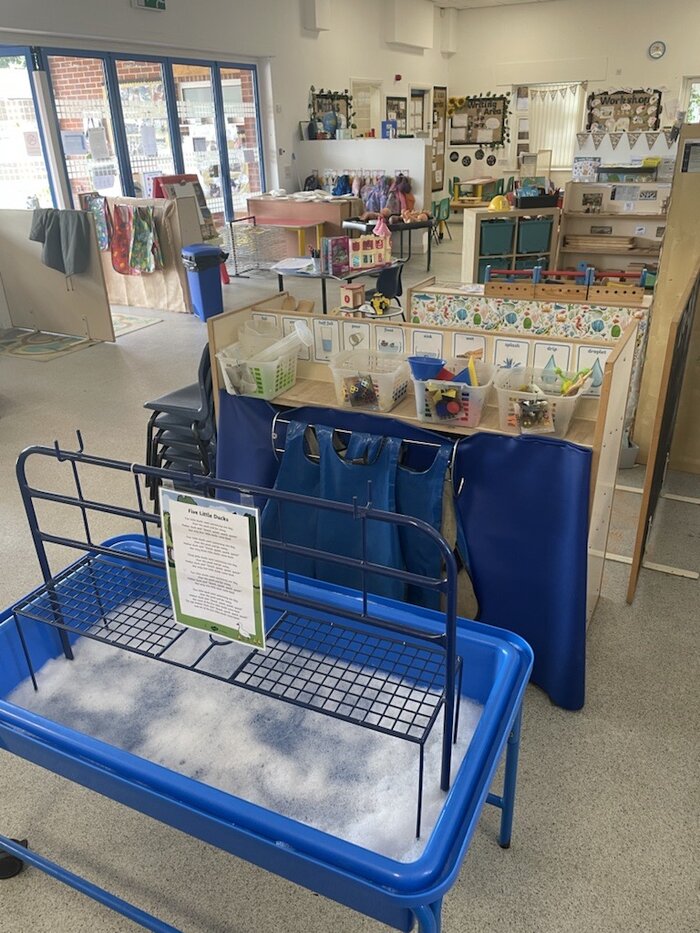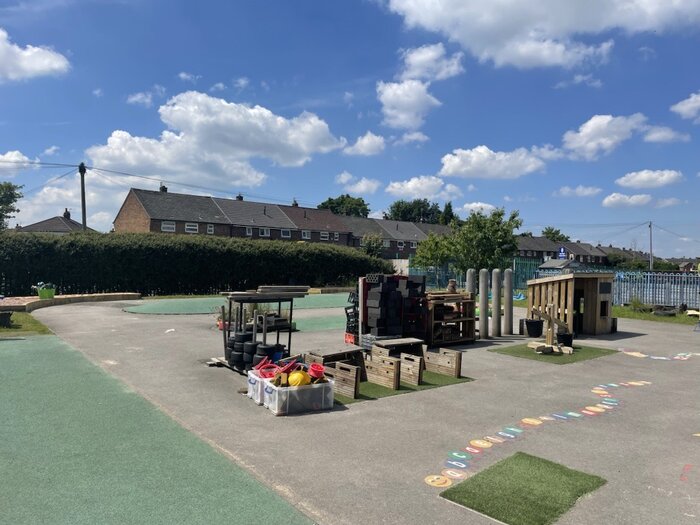
Articles
We aim to give food for thought as well as inspiring your creativity and
providing practical ideas you can’t wait to implement in your own settings!
Transition in the Early Years
Early Years practitioner, Cheryl Keyworth, gives us her thoughts and practical suggestions about transition.
(And with practical ideas in mind, please find a downloadable tray label at the end of this article!)

Dane Bank Primary and Nursery School
It is wise to have a subtle approach whilst preparing the children for the next step of their education. The move for the children should be seamless and exciting. The transition can be done without the children even being aware that it’s preparation for their next class move. I have been very fortunate to have worked in Early Years for the past 20 years. Here are some of the ways we deal with transition to nursery, to reception, and finally to year 1.
Starting Nursery
In nursery, we are proactive in helping prepare the new starters.
We visit all the new nursery starters in either their current setting or their home. This enables us to meet the children for the first time, in an environment where they are familiar and confident and gather that all-important information about them.
The next step is to invite the children into school for a ‘Stay and Play’ morning, accompanied by their parent/carer. This is an opportunity to begin to build relationships and is crucial in a providing the best education for the children. The parents are made aware that there is an open-door policy and encouraged to share as much information about the child as possible. We also have the chance to observe and chat to the children whilst allowing them the time to explore what will soon be their new nursery environment.
We send home a welcome letter, information pack, story book and little Dane Bank School teddy bear. The pack includes photos of their new nursery environment.
The children are welcomed in September in small groups. This allows the teachers time to get to know each child, teach them their new routine and settle them into nursery class before the next group of new children arrive a few days later. These first few days are spent teaching routines and getting to know the children. They bring a ‘Summer Book’ (which is filled with photos and stories of what they have done with their families over the Summer). The books provide a perfect tool for encouraging the children to talk about places and people that are familiar to them.

Nursery to Reception Class
Most of our new reception class cohort starting in September (around 20 out of 30 children) have already attended our nursery. They are, therefore, already familiar with the reception teachers and the environment. The reception class teachers have had lots of interaction with the nursery children over the year, both in the outdoor environment and also in our middle zone. The middle zone is a shared Nursery/Reception area. All children have access to play in this area and the teachers are on a rota to go in this area each day. The focus here is on developing the speaking and listening skills of the children. This is done by joining the children in their play within the continuous provision.
The new reception children who are coming from other settings, are visited in their current settings. Again, it is an opportunity to meet their new teacher and the teacher can chat to their current provider to gather as much information about the children as possible. A ‘Summer Book’ is given to be filled in. This again provides the perfect chance to open communication with the children when they start school in September.
At the beginning of the final half term, around the middle of June, the new parents are invited into school to a ‘new to reception’ class meeting. All the teachers and teaching assistants are present to meet the new children and parents alike. There is a PowerPoint giving information about the school, including its values and expectations. It also explains how the school day is set out in reception class. In the meeting the parents are asked to prepare their children for starting in reception class by:
- ☉ encouraging use of the toilet independently (where possible)
- ☉ talking to their child about what to expect when starting school
- ☉ supporting them to put on coats and shoes independently
- ☉ explaining the importance of reading books
- ☉ singing nursery rhymes and number songs with their children.
The parents and children are then introduced to the reception class and given time to play and explore their new setting.
There are the current ‘big books’, full of this year’s lessons and learning, left for the parents to browse. These exemplify the learning of the children in the current reception class.
There is a selection and explanation of the phonic scheme which the children will follow and an emphasis on the importance of reading books at home. This is an opportunity for teachers to chat to parents and the children for the first time.
The communication between teacher/parent is high on our list of our priorities at Dane Bank. This is made very clear to the parents. We have an open-door policy, a Dojo messaging service, text messages and Twitter. We message all parents on the first morning to let them know their child has settled. We make a point of speaking to every parent during the first week, to give quick feedback as to how their child has settled. We appreciate how emotional it is for parents as their child starts school. We send home a little note on the first day. It has a photo of the child, what they did, who they played with and what they ate. It is information all parents want to know and probably all the things their child will not remember when they get home after a long day.
The children are invited in again for a morning around the middle of July. They come into school to spend the whole morning without their parents. They can meet the staff again and the other children in their new class. Again, it is precious time to chat with the children and become more familiar with them as they play in their new environment.
The children are all assigned a buddy from year 5. The buddy sends them a postcard at the end of July. They introduce themselves and tell them they will help them settle into school. They will come into reception in September to read a book, draw a picture, help them at lunchtime etc. It is a lovely relationship which benefits the slightly older and younger children alike.
Throughout the transitional period of the final half term, I am aware that the Early Years is a crucial phase for the children. It has its own curriculum and although transitional procedures are vital to prepare the children, it is important to continue following the EYFS curriculum until the very end of reception class year. All the scores and data have been submitted by now, it leaves valuable time to completely focus on speaking and listening. We join the children in their play on a more frequent basis to encourage conversations and interactions. It is truly a lovely time of the year.
Their learning is not a preparation for year 1!

Reception to Year 1
The reception children have been playing on the BIG playground all year at lunch times. This will be their playground in year 1 and therefore the transition to this will be smooth.
They carry on with the same buddy from reception class whilst in year 1. This is great continuity and the buddies come down occasionally to help settle them into year 1 in the first couple of weeks.
There is a whole school transition morning in mid-July. This is a morning where all children go to their new class for the morning and spend some time in their new environment with their new teacher.
At the beginning of September, there is a meet the teacher session. The parents are invited to their child’s new class to meet the new teacher. It is a chance to share information about the children and get to know each other.
In year 1, the children continue to access continuous provision for the whole year. This is fabulous for the children as they transition to a new curriculum and a new class. They still have that wonderful time to play, explore and chat together during the school day.

Tray labels from EuHu
Ask children to create and colour in their own tray labels.
This is a gentle activity to ease children into their new classroom environment and get a head-start on preparations for September.

Download here
With many thanks to Cheryl Keyworth for sharing her many years’ experience of transition.
Cheryl has been a teacher for 20 years and is passionate about the Early Years.